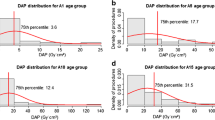Purpose:
To investigate the influence of local density increase by i.v. contrast agent on dose calculation in linac-based radiosurgery (RS) of cerebral arteriovenous malformations (AVMs).
Material and Methods:
RS was performed after three-dimensional (3-D) treatment planning using a total number of nine to 14 beams. Mean target volume was 5.3 cm3 (range, 0.1–41.2 cm3). Mean maximum diameter was 23.2 mm (range, 8–51 mm). Dose deviation was estimated and calculated from the enhanced and unenhanced datasets of 30 patients. Dose calculation was performed using the same RS treatment plan on both datasets. Both plans were standardized to 1 Gy at isocenter with the same dose weight for all beams.
Results:
Mean difference of Hounsfield units (ΔHU) between enhanced and unenhanced CT was 152 HU (range, 50–350 HU). The estimated dose deviation was ≤ 1% in 80% of cases with a mean deviation of 0.67% and a maximum dose deviation of 1.8%. With increasing ΔHU and increasing maximum diameter dose deviation increased as well. The calculated overdosage in ten datasets of enhanced and unenhanced CT scans was 0.66% mean (range, 0.2–1.2%).
Conclusion:
The use of i.v. contrast agent in 3-D treatment planning for RS of cerebral AVMs may lead to an underestimation of actual applied dose. The effect on dose calculation is rather low with dose deviations < +1% in most of the cases. However, there are cases especially in large AVMs with high ΔHU located next to critical, radiosensitive structures in which an additional unenhanced CT scan is recommended for exact dose calculation to avoid side effects.
Ziel:
Untersuchung des Einflusses der lokalen Dichteerhöhung durch Röntgenkontrastmittel auf die Dosisberechnung bei der Radiochirurgie (RS) von zerebralen arteriovenösen Malformationen (AVM).
Material und Methodik:
Die RS erfolgte nach dreidimensionaler (3-D) Bestrahlungsplanung über 9 bis 14 Felder. Die mittlere Zielvolumengröße lag bei 5,3 cm3 (Spanne 0,1–41,2 cm3). Der mittlere maximale Durchmesser betrug 23,2 mm (Spanne 8–51 mm). Die potentielle Dosisabweichung wurde anhand eines nativen und eines kontrastmittelverstärkten Datensatzes von 30 Patienten bestimmt. Die Berechnung der Dosisverteilung zur RS erfolgte jeweils auf beiden Datensätzen. Beide Pläne wurden zum Vergleich auf 1 Gy im Isozentrum normiert, mit einer gleichmäßigen Dosisgewichtung über alle Felder.
Ergebnisse:
Die mittlere Differenz der Hounsfield-Einheiten (ΔHU) zwischen kontrastverstärktem und nativem CT lag bei 152 HU (Spanne 50–350 HU). Die geschätzte Dosisabweichung betrug in 80% der Fälle ≤ 1% mit einer mittleren Abweichung von 0,67% und einer maximalen Abweichung von 1,8%. Mit zunehmender ΔHU und zunehmendem maximalem Durchmesser nahm auch die Dosisabweichung im Sinne einer Überdosierung zu. Die berechnete mittlere Dosisabweichung lag bei zehn nativen und kontrastverstärkten Datensätzen bei 0,66% (Spanne 0,2–1,2%).
Schlussfolgerung:
Die Verwendung von Röntgenkontrastmittel zur 3-D-Bestrahlungsplanung kann zu einer Unterschätzung der tatsächlich applizierten Dosis bei der RS von zerebralen AVM führen. Der Effekt auf die Dosisberechnung ist eher gering, mit Dosisabweichungen < +1% in den meisten Fällen. Jedoch ist die Durchführung eines zusätzlichen nativen CT zur exakten Dosisberechnung, insbesondere bei großen AVM mit großem ΔHU in unmittelbarer Nähe zu kritischen, strahlenempfindlichen Organen, zur Vermeidung von Nebenwirkungen sinnvoll.
Similar content being viewed by others
References
Flickinger JC, Kondziolka D, Maitz AH, et al. An analysis of the dose-response for arteriovenous malformation radiosurgery and other factors affecting obliteration. Radiother Oncol 2002;63:347–54.
Georg D, Georg P, Hillbrand M, et al. Assessment of improved organ at risk sparing for advanced cervix carcinoma utilizing precision radiotherapy techniques. Strahlenther Onkol 2008;184:586–91.
Hamm KD, Klisch J, Surber G, et al. Special aspects of diagnostic imaging for radiosurgery of arteriovenous malformations. Neurosugery 2008;62:A44–52.
Henzel M, Hamm K, Gross MW, et al. Fractionated stereotactic radiotherapy of glomus jugulare tumors. Local control, toxicity, symptomatology, and quality of life. Strahlenther Onkol 2007;183:557–62.
Knoos T, Nilsson M, Ahlgren L. A method of conversion of Hounsfield numbers to electron density and prediction of macroscopic pair production cross sections. Radiother Oncol 1986; 5:337–45.
Kocher M, Frommolt P, Borberg SK, et al. Randomized study of postoperative radiotherapy and simultaneous temozolomide without adjuvant chemotherapy for glioblastoma. Strahlenther Onkol 2008;184:572–9.
Langsenlehner T, Stiegler C, Quehenberger F, et al. Long-term follow-up of patients with pituitary macroadenomas after postoperative radiation therapy. Analysis of tumor control and functional outcome. Strahlenther Onkol 2007;183:241–7.
Milker-Zabel S, Zabel-du Bois A, Huber P, et al. Fractionated stereotactic radiation therapy in the management of benign cavernous sinus meningiomas. Long-term experience and review of the literature. Strahlenther Onkol 2006;182:635–40.
Parker RP, Hobday PA, Cassell KJ. The direct use of CT numbers in radiotherapy dosage calculations for inhomogeneous media. Phys Med Biol 1979;24:802–9.
Preiser K. Ein neues Programm zur Einführung der inversen Strahlentherapieplanung in die klinische Praxis. Inauguraldissertation, Medizinische Fakultät der Ruprecht-Karls-Universität Heidelberg, 1997.
Ramm U, Damrau M, Mose S, et al. Influence of CT contrast agents on dose calculations in a 3D treatment planning system. Phys Med Biol 2001;46:2631–5.
Schlienger M, Atlan D, Lefkopoulos D, et al. Linac radiosurgery for cerebral arteriovenous malformations: results in 169 patients. Int J Radiat Oncol Biol Phys 2000;46:1135–42.
Schneider U, Pedroni E, Lomax A. The calibration of CT Hounsfield units for radiotherapy treatment planning. Phys Med Biol 1996;41:111–24.
Thomas SJ. Relative electron density calibration of CT scanners for radiotherapy treatment planning. Br J Radiol 1999;72:781–6.
Zabel A, Milker-Zabel S, Huber P, et al. Treatment outcome after linac-based radiosurgery in cerebral arteriovenous malformations: retrospective analysis of factors affecting obliteration. Radiother Oncol 2005;77:105–10.
Author information
Authors and Affiliations
Corresponding author
Rights and permissions
About this article
Cite this article
Zabel-du Bois, A., Ackermann, B., Hauswald, H. et al. Influence of Intravenous Contrast Agent on Dose Calculation in 3-D Treatment Planning for Radiosurgery of Cerebral Arteriovenous Malformations. Strahlenther Onkol 185, 318–324 (2009). https://doi.org/10.1007/s00066-009-1927-6
Received:
Accepted:
Published:
Issue Date:
DOI: https://doi.org/10.1007/s00066-009-1927-6
Key Words:
- Arteriovenous malformations (AVMs)
- Dose calculation
- Contrast agent
- 3-D treatment planning
- Radiosurgery (RS)




